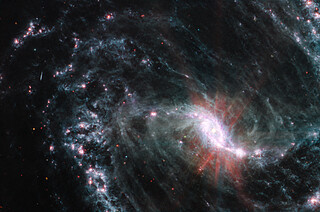Spiral Galaxy
A spiral galaxy typically has a rotating disc with spiral ‘arms’ that curve out from a dense central region. The Milky Way is a spiral galaxy.
Four classes are used to classify galaxies: spiral; barred spiral; elliptical and irregular. Spiral galaxies have a complex structure: a dense central bulge lies at the centre of a rotating disc, which features a spiral structure that originates at the bulge. Spiral galaxies are surrounded by sparsely populated halos — roughly spherical regions above and below the plane of the discs. Barred spirals differ from normal spiral galaxies in that the arms of the galaxy do not lead all the way into the centre, but are connected to the two ends of a straight bar of stars which contains the nucleus at its centre. Approximately two-thirds of all spiral galaxies are thought to be barred spiral galaxies. Classifying spiral galaxies is not always straightforward, as their appearance varies considerably depending on their orientation relative to Earth. The most visually spectacular spiral galaxies are ‘face-on’, meaning that their bulge and all their spiral arms are clearly visible. The most challenging to identify are fully ‘side-on’, meaning that only the outer edge of one side of the galaxy’s arms is visible. The Milky Way is thought to be a barred spiral galaxy. Approximately 60% of all galaxies are thought to be spiral galaxies, making spiral galaxies the home of the majority of the stars in the Universe. Spiral galaxies are populated by stars that are on average much younger than those that populate elliptical galaxies, and current thinking suggests that spiral galaxies may evolve into elliptical galaxies. Spiral galaxies rotate, and their spiral shape is not stable. A puzzle of modern astronomy is how spiral galaxies maintain their spiral arms.
Webb's various detectors are well-suited to gaining a full understanding of spiral galaxies, helping astronomers to research how they grow and evolve. In this combined mid-infrared and near-infrared image of Stephan's Quintet, one of Webb's first images and featuring three spiral galaxies, bright and newly-formed stars are seen clearly by NIRCam while MIRI highlights the hot dust and broad galactic structure.
Most spiral galaxies in the Universe have a bar structure in their centre, and Webb’s images of NGC 7496 and NGC 1433 offer some examples. On the other hand, M74 is an example of a spiral galaxy without a bar, its arms all radiating from a compact core. It is also a 'grand design' spiral galaxy, defined by prominent and regular arms as compared to other, patchier spiral galaxies.




